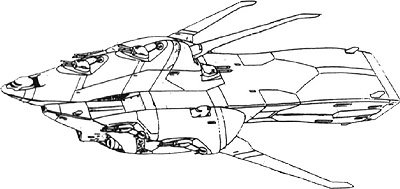|
Astrarza
Unit
type: battleship/carrier Simultaneously with its development of mobile suits for space combat, the Space Revolutionary Army also set about developing for itself a first-rate space navy ("spacy") modelled around the tenets of mobile suit combat. To make the best use of their limited resources, the Army opted to base their overall strategy on having the fewest number of different hulls as possible, allowing for more economical production. The Astrarza served as the Army's standard fleet combatant, developed as both a heavily armed battleship and mobile suit carrier vessel. As a result, it is a ship of significant size and rather poor maneuverability. Cloud Nine's military strategists (accurately) predicted that a space battle's decisive actions would be conducted by mobile suits, and were therefore willing to accept a somewhat sluggish capital ship provided it could bring a major amount of firepower and field a large number of mobile suits at once, which the Astrarza is more than capable of. The battleship bristles with heavy weapons, mounting seven double-barreled beam cannons of a very large caliber. Because of the ship's unusual shape, it is fully capable of directing its main guns in any direction, although maximum firepower is concentrated over the frontal arc. Because of its ponderous size, the Astrarza is vulnerable to attacks by enemy mobile suits, resulting in the mounting of a heavy antiaircraft battery. Laser cannons are installed directly behind each of the battleship's main artillery, providing it with equivalent air defense. Finally, six reaction missiles - perhaps the most devastating portable weapons fielded by the Army - are stored in the lower hull below the catapults, intended to obliterate entire enemy ship squadrons or to crack open fortified asteroids (and, presumably, PLANTs). The weapons are essentially highly-efficient fusion-type nuclear warheads using a complex laser detonation system - although this requires the Astrarza to maintain line-of-sight with the missiles until detonation, it also allows them to be used even in areas under the effect of a Neutron Jammer. However, Army planners intended from the beginning for the Astrarza's mobile suits to be its most effective weapon, and a two full squadrons can be embarked in the spacious hangar that occupies most of the central hull. Two catapults on either side of the "hump" allow for rapid deployment and recovery of embarked mobile suit teams, allowing the Astrarza to get its forces into the field quickly as well as re-arm and re-fuel mid-combat with great rapidity. The three very large antennas on the Astrarza's hull offer it a high degree of sensor effectiveness, essential for maintaining communication with its mobile suits during deployments. The end of the Space War and the demobilization of the Space Revolutionary Army in UC 224 marked the end of wartime service of the well-regarded Astrarza and other vessels employed by Cloud Nine's military. While highly effective in shootouts with much smaller ZAFT vessels, the Astrarza's capability in a large-scale fleet engagement was never truly tested, giving the highly mobile combat that occured between ZAFT and the Army. Most of the Astrarza-class ships that survived the climactic battles at the end of the war were retained by the Cloud Defense Service, although their reaction missiles were dismounted under arms limitation treaties signed after the end of hostilities. At least a few Astrarzas turned up in the hands of other operators as well - the battleship's high firepower and mobile suit capacity would make it an exceptionally attractive base of operations for very well-financed pirates. |



